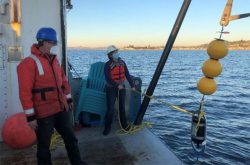
The release of methane, a powerful greenhouse gas responsible for almost a quarter of global warming, is being studied around the world, from Arctic wetlands to livestock feedlots. A University of Washington team has discovered a source much closer to home: 349 plumes of methane gas bubbling up from the seafloor in Puget Sound, which holds more water than any other U.S. estuary.
The columns of bubbles are especially pronounced off Alki Point in West Seattle and near the ferry terminal in Kingston, Washington, according to a study in the January issue of Geochemistry, Geophysics, Geosystems.
“There’s methane plumes all over Puget Sound,” said lead author Paul Johnson, a UW professor of oceanography. “Single plumes are all over the place, but the big clusters of plumes are at Kingston and at Alki Point.”
Read more at UW News »
